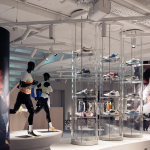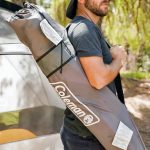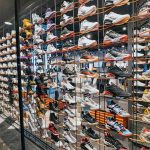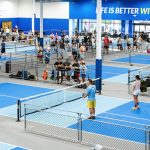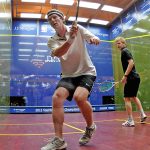At the Bank of America Merrill Lynch Consumer & Retail Conference last week, Ken Hicks, Foot Locker’s president and CEO, elaborated on the success Foot Locker has had since he took over in 2009 but particularly talked up the growth drivers of the future, particularly Runners Point, women and kids.
Hicks noted that in 2009, Foot Locker was “really a one leg stool with men's basketball through US brick-and-mortar.” Since then, it has built up a “robust kids business,” a “developing women’s business,” a stronger running and casual footwear mix, and an “improving” apparel business. Heightened banner differentiation has helped each of the its banners inside the mall stand out with a “distinct purpose.”
It’s also become “much more global” over the last few years with expansion and the acquisition of Germany’s Runners Point as well as “very much a digital company” with Eastbay and its rapidly-expanding store banner websites.
Asked what’s supporting Foot Locker’s call for a bullish mid-single digit comp this year, Hicks said Foot Locker has “a lot of great ideas coming from the vendors,” citing examples like Element from Adidas, Speedform from Under Armour or a strong lineup of basketball shoes from Nike. The athletic trend also remains strong, with basketball not only still making a strong comeback but running holding potential for a strong year “because there's so much new product coming out.”
Hicks also listed a number of internal initiatives that should continue to pay off, including building on its kids momentum, European expansion, online initiatives, and remodels.
Regarding the resurgence in its kids over the last few years, Hicks said Kids Foot Locker as well as its other banners’ kids areas are benefiting from remodels. Foot Locker “really didn't have a kids apparel business,” previously and the remodels particularly emphasize apparel hooks up to footwear. That not only helps kids apparel sales but footwear as well. A new in-store shop with Nike, called Kids Fly Zone, is doing well.
But Hicks also said Foot Locker’s kids business has clearly benefited from the stronger shift toward athletic footwear for kids at the expense of brown shoes, more vendors coming out with kids-specific models, and more takedowns of marquee releases for kids. Added Hicks, “From our perspective we've still got some legs on the kids business that will run for quite a while.”
Hicks said Runners Point in Germany has the potential to expand to France, Poland, Scandinavia, Turkey and other countries. Said Hicks, “Our running and apparel business there is significant opportunities as we continue to improve our private brands, continue to improve the brands and grow the running business as utilizing knowledgeable associates to make sure that we are able to take care of the customers.”
Regarding the women’s opportunity, Hicks said Foot Locker has a “much better feel” about its women’s prototype, SIX:02, since the first one opened a year and a half ago. This includes around notions around the size of the store, the target customer, the likely product mix, type of associates necessary, and complementary amenities. SIX:02 will open “a few more stores this spring that are closer to exactly what we want.” If they meet expectations, a largely roll out will follow. Said Hicks, “I want to build several hundred of the right store ultimately.”
Indeed, he said Foot Locker is more sure of the opportunity given the belief that active women are far from satisfied with current options in the retail marketplace.
“Lululemon is too expensive,” said Hicks. “Athleta, Lucy, too fashionable. Dick's is not a really comfortable environment.”
He also noted that Lady Foot Locker is “too much about shoes,” although that’s being changed with a new Bridgewater format that features more apparel. Overall, Hicks said that with “several billion-dollar men's brands, there's no reason we can't have a billion-dollar women's brand.”
On the apparel opportunity, Hicks said Foot Locker’s focus on that category prior to 2009 was primarily selling “cotton by the pound” with the new focus on premium apparel. The chains have “had good success with several of the brands,” and FL is still looking to complement those with private label fill-in opportunities “where the brands may not be offering either a product like casual shorts or a price point.”
Hicks also indicated he’s more than comfortable with Foot Locker’s narrow list of suppliers. Although margin pressures are always there, Hicks indicated it helps the vendors if Foot Locker’s’ business is profitable. He elaborated, “When we start to fall down their business starts to fall down, and they realize having good healthy people all the way through the chain is important to the business.”
He’s also fine with a major exposure to Nike and Adidas since they’re strong brands. Hicks said, “I've been in businesses where I had 100 vendors and none of them were any good. Now I'm in a business where I've got a few vendors and they are really good, and it helps us.”
Finally, asked about Nike and Adidas’ expansion into their own retail stores, Hicks said the “good news is they’re not very good retailers,” believing both vendors aren’t making such expansion a major priority. He also noted that, for example, when the Nike store opened at Roosevelt Field, Foot Locker’s business goes up there since it has a wider Nike assortment in its stores, including special make-ups. Vendors stores also “can be a little intimidating” while a Foot Locker door is “is more inviting,” particularly to the younger person that Foot Locker looks to attract. Said Hicks, “You go into a Nike store, you go into an Adi store, you don't see a lot of kids.”
Asked about Finish Line’s deal to open up in-store shops in Macy’s, Hicks admitted “it wouldn't be true if I said I was happy about it.” But he said Macy’s business tends to be “lower priced, on the whole, and more fashion driven.” He added, “I want to sell sneakers to everybody at $60 and above.”
He also believes Foot Locker’s major vendors “aren't going to do things that are stupid to pull the brand down,” by causing channel conflicts with excessive, overlapping sales through department stores. Noting that Finish Line has found the same reaction, Hicks said the new shops haven’t hurt Foot Licker’s mall business and he suspects that’s another sign of the overall strong athletic trend.
He joked, “People weren't walking around barefoot. Maybe it's what's happening with the brown shoe business.”

